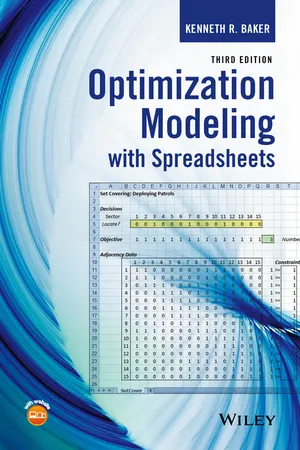
- English
- ePUB (mobile friendly)
- Available on iOS & Android
Optimization Modeling with Spreadsheets
About this book
An accessible introduction to optimization analysis using spreadsheets
Updated and revised, Optimization Modeling with Spreadsheets, Third Edition emphasizes model building skills in optimization analysis. By emphasizing both spreadsheet modeling and optimization tools in the freely available Microsoft® Office Excel® Solver, the book illustrates how to find solutions to real-world optimization problems without needing additional specialized software.
The Third Edition includes many practical applications of optimization models as well as a systematic framework that illuminates the common structures found in many successful models. With focused coverage on linear programming, nonlinear programming, integer programming, and heuristic programming, Optimization Modeling with Spreadsheets, Third Edition features:
- An emphasis on model building using Excel Solver as well as appendices with additional instructions on more advanced packages such as Analytic Solver Platform and OpenSolver
- Additional space devoted to formulation principles and model building as opposed to algorithms
- New end-of-chapter homework exercises specifically for novice model builders
- Presentation of the Sensitivity Toolkit for sensitivity analysis with Excel Solver
- Classification of problem types to help readers see the broader possibilities for application
- Specific chapters devoted to network models and data envelopment analysis
- A companion website with interactive spreadsheets and supplementary homework exercises for additional practice
Optimization Modeling with Spreadsheets, Third Edition is an excellent textbook for upper-undergraduate and graduate-level courses that include deterministic models, optimization, spreadsheet modeling, quantitative methods, engineering management, engineering modeling, operations research, and management science. The book is an ideal reference for readers wishing to advance their knowledge of Excel and modeling and is also a useful guide for MBA students and modeling practitioners in business and non-profit sectors interested in spreadsheet optimization.
Frequently asked questions
- Essential is ideal for learners and professionals who enjoy exploring a wide range of subjects. Access the Essential Library with 800,000+ trusted titles and best-sellers across business, personal growth, and the humanities. Includes unlimited reading time and Standard Read Aloud voice.
- Complete: Perfect for advanced learners and researchers needing full, unrestricted access. Unlock 1.4M+ books across hundreds of subjects, including academic and specialized titles. The Complete Plan also includes advanced features like Premium Read Aloud and Research Assistant.
Please note we cannot support devices running on iOS 13 and Android 7 or earlier. Learn more about using the app.
Information
1
INTRODUCTION TO SPREADSHEET MODELS FOR OPTIMIZATION
BOX 1.1 Excel Skills Assumed as Background for This Book
1.1 ELEMENTS OF A MODEL
EXAMPLE 1.1 Price, Demand, and Profit
Table of contents
- COVER
- TITLE PAGE
- TABLE OF CONTENTS
- PREFACE
- 1 INTRODUCTION TO SPREADSHEET MODELS FOR OPTIMIZATION
- 2 LINEAR PROGRAMMING: ALLOCATION, COVERING, AND BLENDING MODELS
- 3 LINEAR PROGRAMMING: NETWORK MODELS
- 4 SENSITIVITY ANALYSIS IN LINEAR PROGRAMS
- 5 LINEAR PROGRAMMING: DATA ENVELOPMENT ANALYSIS
- 6 INTEGER PROGRAMMING: BINARY-CHOICE MODELS
- 7 INTEGER PROGRAMMING: LOGICAL CONSTRAINTS
- 8 NONLINEAR PROGRAMMING
- 9 HEURISTIC SOLUTIONS WITH THE EVOLUTIONARY SOLVER
- Appendix 1: SUPPLEMENTAL FILES AND SOFTWARE
- Appendix 2: GRAPHICAL METHODS FOR LINEAR PROGRAMMING
- Appendix 3: THE SIMPLEX METHOD
- INDEX
- END USER LICENSE AGREEMENT